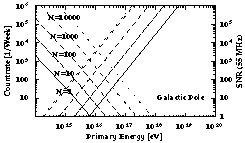
Detecting Radio Emission from Cosmic Ray Air Showers and Neutrinos with a Digital Radio Telescope
Heino Falcke1 & Peter Gorham2
1Max-Planck-Institut für Radioastronomie, Auf den Hügel 69, D-53121 Bonn, Germany (hfalcke@mpifr-bonn.mpg.de)1Dept. of Physics \& Astronomy, Univ. of Hawaii at Manoa, 2505 Correa Rd., Honolulu, HI, 96822, USA (gorham@phys.hawaii.edu)
Astroparticle Physics (2002), in press
Electronic Preprint: PostScript and astro-ph/0207226Abstract:
We discuss the possibilities to measure ultra-high energy cosmic rays and neutrinos with radio techniques. We review a few of the properties of radio emission from cosmic ray air showers that have been found in the past. We show how these properties can be qualitatively explained through coherent synchrotron emission from electron-positron pairs in the shower as they move through the earth's magnetic field. A new generation of digital telescopes makes it now possible to study this radio emission in greater detail. For example, the planned the Low-Frequency Array LOFAR, operating at 10-200 MHz, will be a uniquely suited instrument to study extensive air showers and even detect neutrino-induced showers on the moon. We discuss sensitivities, count rates and possible detection algorithms for LOFAR which should also be applicable to other digital radio telescopes such as the Square-Kilometer-Array (SKA). LOFAR will be capable of detecting air-shower radio emission from >2*1014 eV to ~1020 eV. The technique could be easily extended to include air shower arrays consisting of particle detectors, thus providing crucial additional information for obtaining energy and chemical composition of cosmic rays and to extend the cosmic ray search well beyond an energy of 1021 eV. Other issues that LOFAR can address are to determine the neutral component of the cosmic ray spectrum, possibly look for neutron bursts, and do actual cosmic ray (neutron) astronomy.
Paper: Available in PostScript and (Elsart)LaTex. Please send an email request to hfalcke@mpifr-bonn.mpg.de for a preprint.
Other publications can be found here.
Questions: Heino Falcke, hfalcke@mpifr-bonn.mpg.de